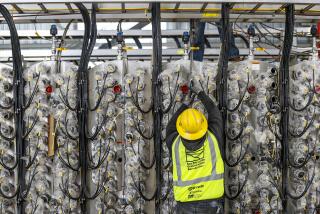N. Hollywood Firms Told to Hook Up With Sewers
In a move to protect San Fernando Valley ground water supplies, 66 businesses in the North Hollywood area have been given a year by city officials to abandon their septic disposal systems and hook up to city sewers.
Hookup notices were mailed last week to 47 commercial and industrial firms; in May, 19 businesses were issued notices, according to officials with the Los Angeles city Department of Public Works.
It will be about a year before hookup orders reach all of the estimated 1,400 Valley businesses that have access to city sewers but still use septic tanks or cesspools, according to Robert Alpern, principal sanitary engineer with the Bureau of Sanitation, a branch of the public works department.
The sewer connections are required under a city ordinance adopted in September. The law is intended to reduce the risk of further chemical contamination of Valley wells that furnish about 15% of the Los Angeles water supply.
Residential properties of less than five dwelling units are exempt, but all other Valley businesses that use septic tanks but have access to sewers must be connected within a year of receiving a notice.
Public works officials said the notifications are being staggered over a year so city engineers will have time to review plans and issue required plumbing and sewer connection permits.
They said the first notices have gone to North Hollywood-area auto repair firms, metal shops and similar businesses near water supply wells that have displayed the worst contamination. Valley businesses farther from the wells will be notified later.
Last year, city officials estimated that there might be 3,000 Valley businesses on septic tanks or cesspools with access to city sewers. But the current estimate, based on a door-to-door survey by a brigade of city industrial-waste inspectors earlier this year, is less than half of that.
Properly abandoning a septic system and connecting to a sewer is an expensive proposition.
Bob Van Ark, a Van Nuys section chief with the public works department’s Bureau of Engineering, said the cost might be $2,500 to $5,000 for the average small business, while large establishments could pay much more.
Under the city ordinance, a business ordered to connect can obtain a variance from the Bureau of Sanitation by proving two things: that continued use of a septic system will not pollute water and that connecting to a sewer will create an extreme financial hardship.
Sewer Extensions Planned
In a companion program, the city is planning to extend sewers over the next several years into commercial and industrial areas of the Valley. This program also would affect several hundred firms, which would be required to abandon their septic tanks after the sewer arrives. Van Ark said construction of the first of 18 such sewer extensions should start early next year.
Ground water beneath North Hollywood contains small traces of industrial chemicals, particularly trichloroethylene (TCE) and perchloroethylene (PCE). Both are dry-cleaning and metal-degreasing compounds that are suspected of causing cancer after long-term exposure.
Given the time it takes for pollution to migrate through soil, the chemicals may have been discharged many years ago, officials said. The problem extends into the neighboring cities of Burbank and Glendale, which also rely on wells for part of their water supply.
Officials with the Los Angeles Department of Water and Power maintain that there is no health threat from the contaminants because they have shut down the most contaminated wells and are blending water in less polluted ones to meet state health limits.
However, the problem, at the very least, could be a constraint on future supplies, because contaminants have gradually invaded more wells.
Problem Spotted in 1980
Once the problem was discovered around 1980, septic tanks were quickly identified as one possible source of contamination. And tests in 1982 on waste from a few septic tanks provided evidence that chemicals had gone into some of these tanks, which were supposed to be used only for sewage.
City officials, however, have no clear explanation as to why it took until last year to begin dealing with the problem in the sensitive North Hollywood area.
Although Mayor Tom Bradley and his chief of staff, Tom Houston, have been pushing a state ballot initiative to protect water supplies from toxic contaminants, Houston said recently that he was not aware that some businesses in the North Hollywood area were still on septic tanks.
And, in an interview earlier this year, City Councilman Ernani Bernardi, who represents portions of North Hollywood, said phasing out a septic system is something “you just don’t do . . . overnight.”
Alpern, of the Bureau of Sanitation, said Friday that there is no concrete evidence linking the ground water problem to septic disposal--or to other possible causes such as leaky tanks, past spills or deliberate dumping.
However, Alpern said, even the proper use of septic tanks for sewage disposal could threaten ground water.
“We have a very, very large number of people living in the community, and the ground has only a limited capacity to purify sewage,” he said.
More to Read
Sign up for Essential California
The most important California stories and recommendations in your inbox every morning.
You may occasionally receive promotional content from the Los Angeles Times.









